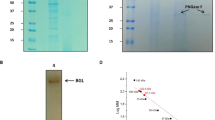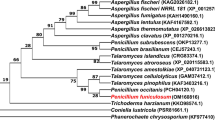Abstract
Endo cellulases of plant pathogenic erwinias degrade cellulose as well as the cellulosic domains of barley (1-3,1-4)-β-glucan. Depolymerization of the latter substrate is mainly caused by (1-3,1-4)-β-glucanases, which hydrolyze (1-4)-β glycosidic linkages adjacent to (1-3)-β linkages. To construct an enzyme for efficient degradation of barley (1-3,1-4)-β-glucan, the sequence encoding the catalytic domain and interdomain linker of the cellulase from Erwinia carotovora subspecies atroseptica was fused to that for the heat stable Bacillus hybrid, H(A12-M)ΔY13 (1-3,1-4)-β-glucanase. The chimeric enzyme secreted from Escherichia coli cells did not remain covalently assembled as judged by SDS-PAGE. However, the glycosylated and intact enzyme (denoted CELGLU) is secreted from the yeast Pichia pastoris. CELGLU exhibits both cellulase and (1-3,1-4)-δ-glucanase catalytic activities, and was accordingly classified a true multienzyme. HPLC and NMR analyses revealed that among the products from CELGLU, di- and trimeric oligosaccharides were identical to those produced by the parental cellulase. Tetrameric oligosaccharides, derived from the (1-3,1-4)-β-glucanase activity of CELGLU, were further degraded by the cellulase moiety to yield glucose and trimers. Compared with the parental enzymes, CELGLU exhibits substantially higher Vmax for degradation of both soluble cellulose and barley (1-3,1-4)-β-glucan. These findings point to construction of multienzymes as an effective approach for engineering enzymes with novel characteristics.
This is a preview of subscription content, access via your institution
Access options
Subscribe to this journal
Receive 12 print issues and online access
$209.00 per year
only $17.42 per issue
Buy this article
- Purchase on Springer Link
- Instant access to full article PDF
Prices may be subject to local taxes which are calculated during checkout
Similar content being viewed by others
References
Woodward, J. R., Fincher, G. B. and Stone, B. A. 1983. Water soluble (1→3), (1→4)-β-D-glucans from barley (Hordeum vulgare) endosperm. II. Fine structure. Carbohydr. Polym. 3: 207–225.
Bock, K., Duus, J. Ø., Norman, B. and Pedersen, S. 1991. Assignment of structures to oligosaccharides produced by enzymic degradation of a β-D-glucan from barley by 1H- and 13C-n.m.r. spectroscopy. Carbohydr. Res. 211: 219–233.
Malet, C., Jiménez-Barbero, J., Bemabé, M., Brosa, C. and Planas, A. 1993. Stereochemical course and structure of the products of the enzymic action of endo-1,3-1,4-β-D-glucan 4-glucanohydrolase from Bacillus licheniformis. Biochem. J. 296: 753–758.
Wood, P. J., Erne, J. D., Teather, R. M., Weisz, J. and Miller, S. S. 1994. Comparison of (1→3)(1→4)-β-D-glucan-4-glucanohydrolases (E.C. 3.2.1.73) from Fibrobacter succinogenes and from Bacillus subtilis and use of high-performance anion exchange chromatography in product characterization. J. Cereal Sci. 19: 65–75.
Wood, P. J., Weisz, J. and Blackwell, B. A. 1994. Structural studies of (1→3)(1→4)-β-D-glucans by 13C-nuclear magnetic resonance spetroscopy and by rapid analysis of cellulose-like regions using high-performace anion-exchange chromatography of oligosaccharides released by lichenase. Cereal Chem. 71: 301–307.
Fincher, G. B. 1975. Morphology and chemical composition of barley endosperm cell walls. J. Inst. Brew. 81: 116–122.
Nevins, D.J., Yamamoto, R. and Huber, D. J. 1978. Cell wall β-D-glucans of five grass species. Phytochemistry 17: 1503–1505.
McFadden, G.I., Ahluwalia, B., Clarke, A. E. and Fincher, G. B. 1988. Expression sites and developmental regulation of genes encoding (1→3, 1→4)-β-glucanases in germinated barley. Planta 173: 500–508.
Woodward, J. R. and Fincher, G. B. 1982. Substrate specificities and kinetic properties of two (1→3),(1→4)-β-D-glucan endohydrolases from germinating barley (Hordeum vulgare). Carbohydr. Res. 106: 111–122.
Parrish, F. W., Perlin, A. S. and Reese, E. T. 1960. Selective enzymolysis of poly-β-D-glucans, and the structure of the polymers. Can. J. Chem. 38: 2094–2104.
Hoy, J.L., Macauley, B. J. and Fincher, G. B. 1981. Cellulases of plant and microbial origin in germinating barley. J. Inst. Brew. 87: 77–80.
Bamforth, C. W. 1985. Biochemical approaches to beer quality. J. Inst. Brew. 91: 154–160.
Campbell, G. L. and Bedford, M. R. 1992. Enzyme applications for mono-gastric feeds: A review. Can. J. Anim. Sci. 72: 449–466.
Olsen, O., Borriss, R., Simon, O. and Thomsen, K. K. 1991. Hybrid Bacillus (1-3,1-4)-β-glucanases: engineering thermostable enzymes by construction of hybrid genes. Mol. Gen. Genet. 225: 177–185.
Battling, S., Wegener, C. and Olsen, O. 1995. Syngergism between Erwinia pectate lyase isoenzymes that depolymerize both pectate and pectin. Microbiol. 141: 873–881.
Greenwood, J. M., Ong, E., Gilkes, N. R., Warren, R. A. J., Miller, R. C., Jr. and Kilburn, D. G. 1992. Cellulose-binding domains: potential for purification of complex proteins. Protein Engng. 5: 361–365.
Rodseth, L.E., Martineau, P., Duplay, P., Hofnung, M. and Quiocho, F. A. 1990. Crystallization of genetically engineered active maltose-binding proteins including an immunogenic viral epitope insertion. J. Mol. Biol. 213: 607–611.
Feng, G., Gray, P. W., Shepard, M. and Taylor, M. W. 1988. Antiproliferative activity of a hybrid protein between interferon-γ and tumor necrosis factor-β. Science 241: 1501–1503.
Nomenclature Committee of the International Union of Biochemistry. 1989. Nomenclature for multienzymes. Eur. J. Biochem. 185: 485–486.
Argos, P. 1990. An investigation of oligopeptides linking domains in protein tertiary structures and possible candidates for general gene fusion. J. Mol. Biol. 211: 943–958.
Politz, O., Simon, O., Olsen, O. and Borriss, R. 1993. Determinants for the enhanced thermostability of hybrid (1-3,1-4)-β-glucanases. Eur. J. Biochem. 216: 829–834.
Keitel, T., Simon, O., Borriss, R. and Heinemann, U. 1993. Molecular and active-site structure of a Bacillus (1-3,1-4)-β-glucanase. Proc. Natl. Acad. Sci. USA 90: 5287–5291.
Cooper, J. C. and Salmond, P. C. 1993. Molecular analysis of the major cellulase (CelV) of Erwinia carotovora: evidence for an evolutionary “mix-and match” of enzyme domains. Mol. Gen. Genet. 242: 341–350.
Bortoli-German, I., Brun, E., Py, B., Chippaux, M. and Barras, F. 1994. Periplasmic disulphide bond formation is essential for cellulase secretion by the plant pathogen Erwinia chrysanthemi. Mol. Microbiol. 11: 545–553.
Henrissat, B. and Bairoch, A. 1991. New families in the classification of glycosyl hydrolases based on amino acid sequence similarities. Biochem. J. 293: 781–788.
Henrissat, B., Claeyssens, M., Tomme, P., Lemesle, L. and Mornon, J.-P. 1989. Cellulase families revealed by hydrophobic cluster analysis. Gene 81: 83–95.
Baird, S.D., Hefford, M. A., Johnson, D. A., Sung, W. L., Yaguchi, M. and Seligy, V. L. 1990. The Glu residue in the conserved Asn-Glu-Pro sequence of two highly divergent endo-β-l,4-glucanases is essential for enzymatic activity. Biochem. Biophys. Res. Commun. 169: 1035–1039.
Py, B., Bortoli-German, I., Haiech, J., Chippaux, M. and Barras, F. 1991. Cellulase EGZ of Erwinia chrysanthemi: structural organization and importance of His98 and Glul33 residues for catalysis. Protein Engng. 4: 325–333.
Wood, W.B., Wilson, J. H., Benbow, R. M. and Hood, L. E. 1981. Proteins in solution and enzyme mechanisms. In: Biochemistry, a Problems Approach. The Benjamin/Cummings Publishing Company, Menlo Park, California.
Malet, C., Jiménez-Barbero, J., Bernabé, M., Brosa, C. and Planas, A. 1993. Stereochemical course and structure of the products of the enzymic action of endo-1,3-1,4-β-D-glucan 4-glucanohydrolase from Bacillus licheniformis. Biochem. J. 296: 753–758.
Saul, D. J., Williams, L. C., Grayling, R. A., Chamley, L. W., Love, D. R. and Bergquist, P. L. 1990. celB, a gene coding for a bifunctional cellulase from the extreme thermophile “Caldocellum saccharolyticum”. Appl. Environ. Microbiol. 56: 3117–3124.
Flint, H.J., Martin, J., McPherson, C. A., Daniel, A. S. and Zhang, J.-X. 1993. A bifunctional enzyme, with separate xylanase and β(1,3-1,4)-glucanase domains, encoded by the xynD gene of Ruminococcus flavefaciens. J. Bacteriol. 175: 2943–2951.
Gilkes, N.R., Kilburn, D. G., Miller, R. C. and Warren, R. A. J. 1989. Structural and functional analysis of a bacterial cellulase by proteolysis. J. Biol. Chem. 264: 17802–17808.
Srisodsuk, M., Reinikainen, T., Penttilä, M. and Teeri, T. T. 1993. Role of the inderdomain linker peptide of Trichoderma reesei cellobiohydrolase I in its interaction with crystalline cellulose. J. Biol. Chem. 268: 20756–20761.
Ong, E., Kilburn, D. G., Miller, R. C. and Warren, R. A. J. 1994. Streptomyces lividans glycosylates the linker region of a β-l,4-glycanase from Cellulomonas fimi. J. Bacteriol. 176: 999–1008.
Studier, F. W., Rosenberg, A. H., Dunn, J. J. and Dubendorff, J. W. 1990. Use of T7 RNA polymerase to direct expression of cloned genes. Methods Enzymol. 185: 60–89.
Sambrook, J., Fritsch, E. F. and Maniatis, T. 1989. In: Molecular Cloning. A Laboratory Manual. Cold Spring Harbor Laboratory Press, New York.
Teather, R. M. and Wood, P. J. 1982. Use of Congo Red-polysaccharide interactions in enumeration and characterization of cellulolytic bacteria from the bovine rumen. Appl. Environ. Microbiol. 43: 777–780.
Ellis, S.B., Brust, P. F., Koutz, P. J., Waters, A. F., Harpold, M. M. and Gingeras, T. R. 1985. Isolation of alcohol oxidase and two other methanol regulatable genes from the yeast Pichia pastoris. Mol. Cell. Biol. 5: 1111–1121.
Chatterjee, A.K., Buchanan, G. E., Behrens, M. K. and Starr, M. P. 1979. Syntheses and excretion of polygalacturonic acid trans-eliminase in Erwinia, Yersinia, and Klebsiella species. Can. J. Microbiol. 25: 94–102.
Cornish-Bowden, A. and Eisenthal, R. 1978. Estimation of Michaelis constant and maximum velocity from the direct linear plot. Biochim. Biophys. Acta. 525: 268–272.
Cheetham, N. W. H., Sirimanne, P. and Royday, W. 1981. High-performance liquid chromatographic separation of carbohydrate oligomers. J. Chromatogr. 207: 439–444.
Kær, M., Andersen, K. V. and Poulsen, F. M. 1994. Automated and semiautomated analysis of homo- and heteronuclear multidimensional nuclear magnetic resonance spectra of proteins: The program Pronto. Methods Enzymol. 239: 288–307.
Author information
Authors and Affiliations
Rights and permissions
About this article
Cite this article
Olsen, O., Thomsen, K., Weber, J. et al. Transplanting Two Unique β-Glucanase Catalytic Activities Into One Multienzyme, Which Forms Glucose. Nat Biotechnol 14, 71–76 (1996). https://doi.org/10.1038/nbt0196-71
Received:
Accepted:
Issue Date:
DOI: https://doi.org/10.1038/nbt0196-71



